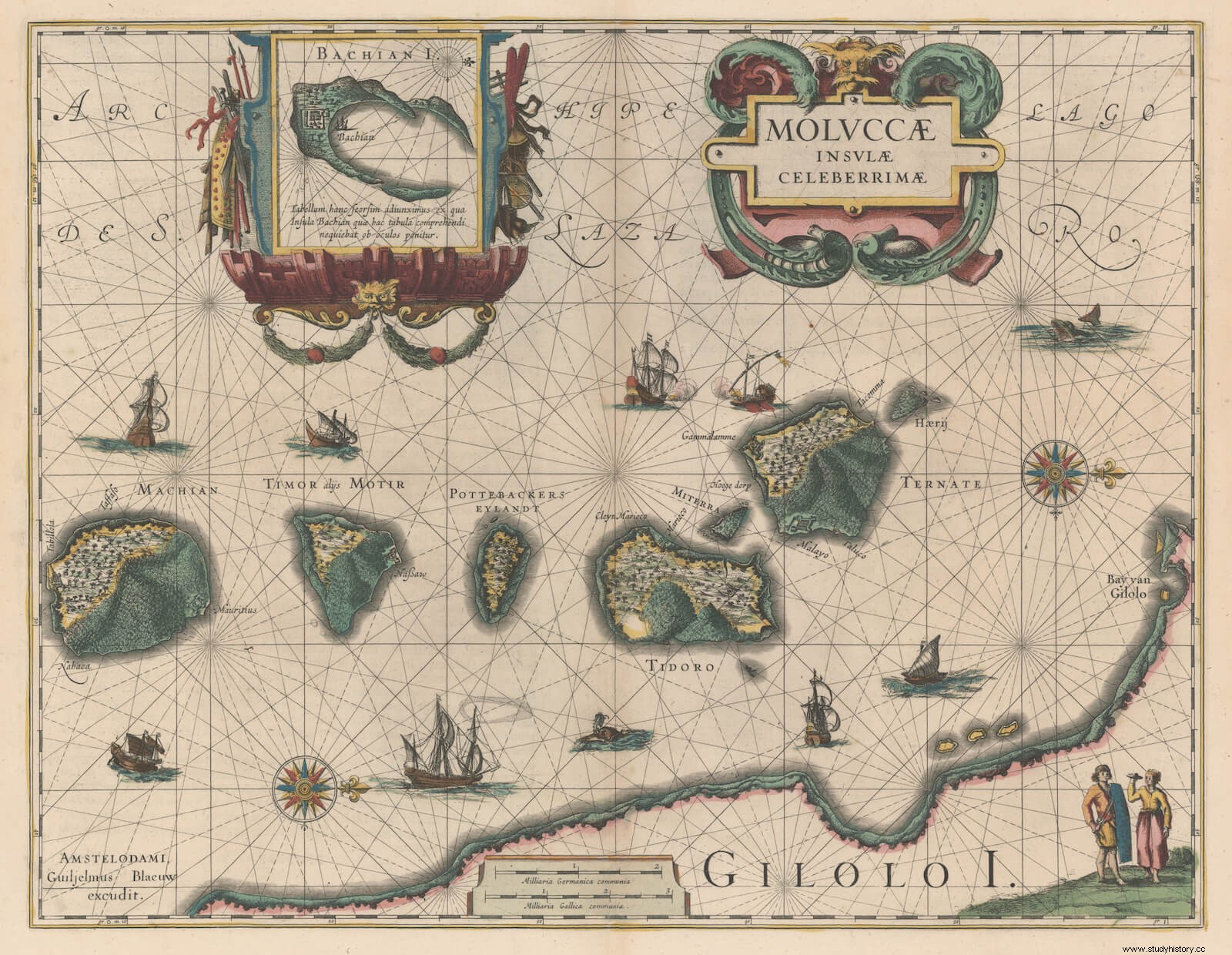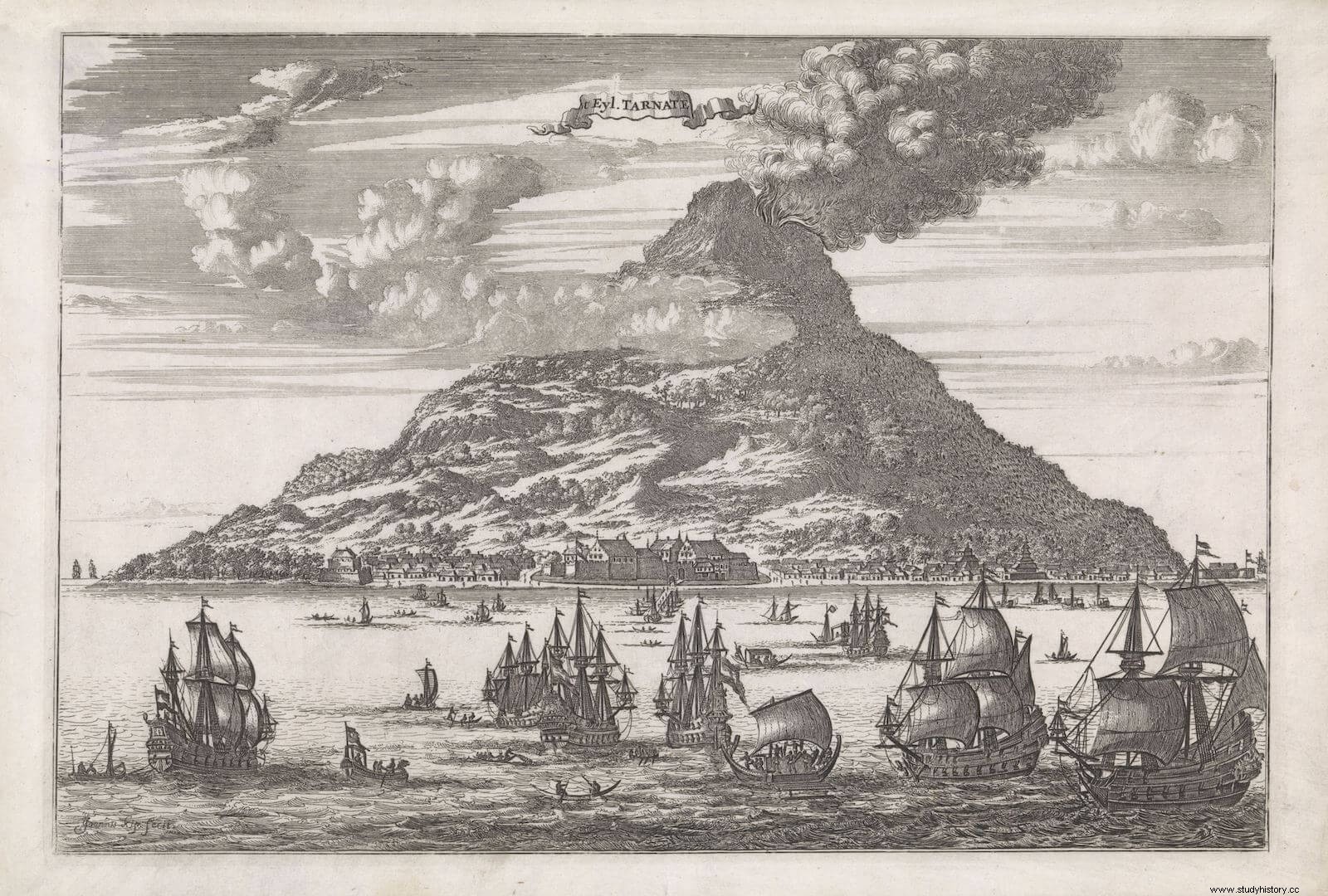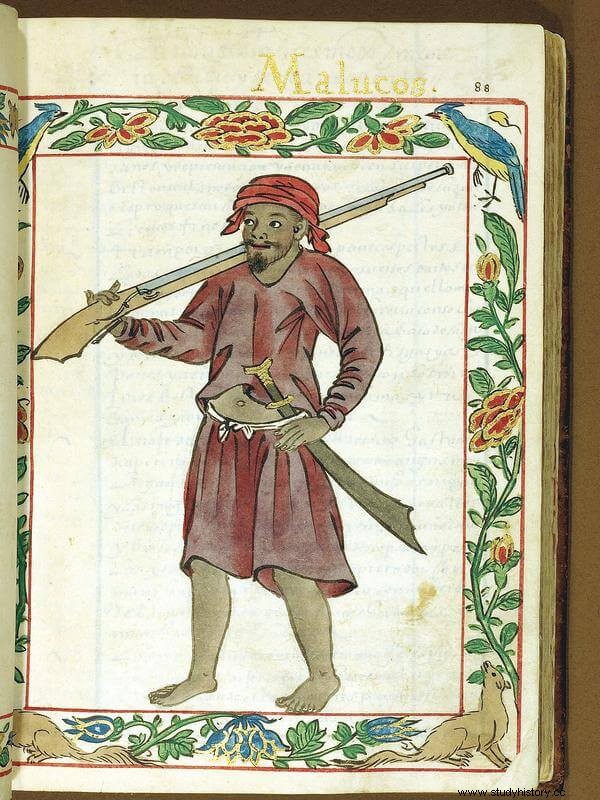
wars, invasions and conquests bring I get language changes , and the case of the Spanish presence in the Philippines and the Malaysian-Indonesian area could not be different. Some dialects of Spanish persist today in that region, originally carried by the soldiers who had the misfortune to end up in that remote destination, or because of the laziness of a secretary of the Council of the Indies who assigned his company, coincidentally at the time in Cadiz or Lisbon, to the Maluco Relief Army, either because of the malice of a lieutenant torticero who, after seducing him with the honey of the militia in an inn in Medina del Campo, Yepes or Lebrija, helped by a pint of young wine from the house, forgot to reveal that the company's destination was not Milan, Naples, Lisbon or Brussels, but the Philippines, although perhaps the unfortunate fledgling ended up in the Maluco region:in Ternate, Tidore, Siao or Tabucas , thousands of miles from Manila.
The Moluccas Islands were a true El Dorado for the Iberians of the 16th century. Lured by spices worth their weight in gold, the Portuguese and Castilians made their way across unknown seas and lands to the source of the coveted riches, which were not only used to season and make even more indigestible the sumptuous game dishes of the European courts, but they were also used as aphrodisiacs by monarchs such as Ferdinand the Catholic himself. “Neither the sky with the demonstrations of the eclipses, nor the great distance of seas that have always been found until now from New Spain to Maluco, with so many dangers and jobs, is enough to illuminate and stop those who allow themselves to be blinded and carried away. his passion”, wrote João de Lucena in his Historia da vida do Padre Francisco Javier (1600).[1] In Maluco the Iberians established a firm presence on the most distant border of their respective empires, which became one with the acquisition of the Portuguese throne by Philip II in 1580.
The situation turned out to be very different in the 17th century, when the Moluccas became the most remote battlefield in the struggle between the Hispanic Monarchy and the insurgent Provinces United , the presence of whose sailors in the guise of knights of fortune in such distant places to seize land and transfer to the natives for dark purposes the benefits of intensive agriculture of spices perhaps responded to the "pestilential rage of Lutherans, Calvinists, Anabaptists, Hussites and a thousand other kinds of accursed opinions that the devil has sown in feasts, banquets and drunkenness in these nations subject to the Tramontane wind”, as Captain Marcos de Isaba suggested, restrained.[2]
There were no more remote presidios in the entire Hispanic empire than those of Ternate and Tidore. To reach them, it was necessary to cross the Atlantic aboard the Fleet of the Indies, cross the Pacific in the Manila Galleon and sail for a month through the uncertain Celebes Sea, a true hotbed of Muslim pirates. Only recruits misled about their destiny got there , criminals from New Spain of particular clumsiness sentenced to serve in the distant prison and uprooted individuals like that Barbary sailor found by the expedition of Luis Váez de Torres on the coast of New Guinea in 1606, "marked on the face with the «s» and the nail, who spoke very good Italian, and told us how he was captivated in the journey of Mr. Don Juan of Austria [the battle of Lepanto] when he was a boy and was sold in Seville to some merchants from Manila in the Philippines.”[3] 
The stable Spanish presence in the Moluccas lasted between 1606 and 1663, although contacts between the kings of Tidore and the Castilians had been common before. In 1520, Juan Sebastian Elcano and his men were well received on the island, and the same can be said of the sailors and soldiers of the failed expeditions of Loaysa (1526), Saavedra (1528), Grijalva (1538) and López de Villalobos (1542). Some of these Spaniards, little seduced by the prospect of a dangerous return trip through the Cape of Good Hope, better known as Cape of Storms, or an uncertain Tornaviaje through unexplored regions of the Pacific where contrary winds were the rule and the waters considered galleons and ships delicacies worthy of their palate, they decided to get off their boats at the last moment to stay on the island, enchanted by the character of the natives, "official and benign with guests", according to the chronicler Bartolomé Leonardo de Argensola,[4] and, why not say it, for the beauty of the women:"of good stature, fat, fresh, beautiful and many of them white", according to the anonymous Boxer Code .[5]
Origin of the apricot
Those who decided to stay in the Moluccas or were forced to do so due to the perennial shortage of recruits willing to be sold as slaves in the Batavian market, had to adapt to a new way of life that altered the landscape, customs and local forms of expression. The Spanish built forts, erected churches and brought missionaries who evangelized hitherto Muslim populations. The influence of the “castillas”, as the Spanish soldiers were known, was soon known in the neighboring seas . "And with the victories that they achieved, in a short time, a proclamation was given, throughout all those islands, of how courageous men the Castillas were," wrote the religious Marcelo de Ribadeneyra.[6]
From Tidore and Ternate, the Spanish presence expanded to the coast of the islands of Gilolo and Sulawesi. The forts and towns with a Hispanic presence became meeting points and cultural exchanges inhabited by the Spanish, Portuguese, mestizos and indigenous people. Naturally, a kind of lingua franca arose in these communities, a creole derived from Spanish that has come to be known as “chabacano” , in which the imprint of the delicate and courteous soldierly prose is very present. So, for example, shit means party, and kesehoda is equivalent to “although” or “despite what”.
In the end, it was those Malay natives, Spanishized and Christianized, who constituted the bulk of the forces that contained the Dutch expansion in Maluco , and they were, in addition, along with their Spanish comrades, the last to see action in the War of Flanders, which, due to jet lag, did not end in the East Indies until after July 18, 1649, a year and a half after the signing of the Treaty of Münster –January 30, 1648–, when a hundred Dutchmen were put to the knife in a fort in Ternate shouting simberguwensas .[7]

The Chabacano language did not disappear with the departure of the Spanish garrison of the Moluccas in 1663 to defend Manila from the ominous threat of the Chinese pirate Koxinga, because the Christianized natives, the márdicas, who had taken a liking to that kind of Spanish in which the pronoun “tú” did not exist, but only “ vos” –something that filled them with pride, since they had quickly assumed the speech of hidalgo de cobragueta of the Spanish soldiers–, they left with the prison and founded a town called Ternate in the Philippine region of Cavite, from where the language spread. spread to other parts of the archipelago. Chabacano currently has more than a million speakers –although the differences between their dialects can make communication difficult– and even with their own means of communication. Also, since 2016 it has been taught in schools and thus stands up to the pressure of Tagalog and English.
The Jesuit Pedro Murillo Velarde y Bravo, already in the middle of the 18th century, made clear the continuity of Chabacano and the zeal with which its speakers preserved it:“the Mardics use three languages, the Spanish that they speak with the Father and the Spaniards, the Tagala in which they communicate with the Indians, and their own (chabacano), which they speak to each other, and communicate and teach their children. They are so fond of their language, an action worthy of more political people.”[8] Good faith of it are the surnames of some of the original mardic families of the Philippine Ternate, which continue to exist today and that, despite their Malay roots, are called Nino Franco, de León, Ramos, de la Cruz, Esteubar, Pereira and Nigoza.[9]
Also in Mindanao and Sulú, conflict zones garrisoned by Spanish troops, varieties of apricot that are still spoken today emerged in the 17th century. , and even in areas where the Spanish presence was weaker, such as northern Sulawesi, traces of Cervantes' language have remained:Manado-Malay contains words such as pasiar (to stroll), toki (touch), Soft (Netherlands), hours (time), kintal (ground), pest (party), kawalo (horse) or settle (kill).[10] The Spanish, therefore, is not limited only to the Hispanic-American sphere; Asia also has things to say about it.
Notes
[1] Quoted in Aganduru Moriz, R. (s. f.):General History of the Western Islands to Adjacent Asia, called Philipines , in (1882) Collection of unpublished documents for the history of Spain , Volume 79, p. 8.
[2] Isaba, M. de (1594):Sick Corps of the Spanish Militia . Madrid:Guillermo Drouy, p. 80.
[3] Prado y Tobar, D. (1607):Summary list of the discovery. that I sinned but fernandez de quiros and I finished him The capan don diego de prado with the assistance of the capan luis baes de torres , f. 13r, State Library of New South Wales.
[4] Argensola, B. L. de (1891):Conquest of the Maluca Islands to King Philip the Third our Lord . Zaragoza:Printing of the Provincial Hospice, p. 11.
[5] Anonymous (ca. 1590):Boxer Codex , f. 89r, Indiana University.
[6] Ribadeneyra, M. de (1601):History of the islands of the archipelago, and kingdoms of Greater China, Tartary, Cochinchina, Malacca, Siam, Cambodia and Japan . Barcelona:Gabriel Graells and Giraldo Dotil, p. 8.
[7] Campo López, Antonio C. (2018):“The last battle of the 80-year war. The war in the Asian colonial confines”, Revista de historia militar , 124, p. 129-160.
[8] Murillo Velarde, P. (1749):History of the Province of the Philippines of the Society of Jesus . Manila:Press of the Society of Jesus, p. 668.
[9] Nigoza, E. (2007):Bahra:The History, Legends, Customs, and Traditions of Ternate, Cavite . Cavite:Cavite Historical Society, p. 14.
[10] Campo López, Antonio C. (2017):“The Spanish presence in North Sulawesi during the 17th century. Study of the Spanish settlement in northern Sulawesi in the face of local opposition and the Dutch threat (1606-1662)”, Revista de Indias , LXXVII/269, p. 76.
Happy December 28th… or maybe not?
In this dystopian 2020, our traditional joke could not be less. What we have offered you today is a meta-innocent, an innocent of an innocent, a false innocent. All the content of this article is strictly true, with a single license, the name of the columnist, a pseudonym behind which the great Àlex Claramunt hides.
